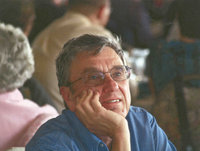Harold Lecar
m |
m |
||
| (4 intermediate revisions by 3 users not shown) | |||
| Line 1: | Line 1: | ||
{{Featured Author|[[User:Lecar|Harold Lecar ]]| | {{Featured Author|[[User:Lecar|Harold Lecar ]]| | ||
[[Image:Harold-2.jpg|left|200px]] | [[Image:Harold-2.jpg|left|200px]] | ||
| − | <strong>Harold Lecar</strong> (b. in Brooklyn, USA, 18 Oct 1935) was educated at Columbia University, where he received his PhD in Physics in 1963 on the use of masers in microwave spectroscopy. From 1963 to 1985 he worked in the Biophysics Laboratory at the American National Institute of Neurological Disorders and Stroke (an NIH institute). Since 1985, he | + | <strong>Harold Lecar</strong> (b. in Brooklyn, USA, 18 Oct 1935, d. 4 Feb 2014) was educated at Columbia University, where he received his PhD in Physics in 1963 on the use of masers in microwave spectroscopy. From 1963 to 1985 he worked in the Biophysics Laboratory at the American National Institute of Neurological Disorders and Stroke (an NIH institute). Since 1985, he became a Professor of Biophysics and Neurobiology at the University of California, Berkeley. |
In 1985, Dr. Lecar received the American Public Health Service Special Recognition Award for “contributions to the understanding of the role of membrane ionic channels in producing electrical excitability and for pioneering work in advancing single-channel methods." | In 1985, Dr. Lecar received the American Public Health Service Special Recognition Award for “contributions to the understanding of the role of membrane ionic channels in producing electrical excitability and for pioneering work in advancing single-channel methods." | ||
| Line 11: | Line 11: | ||
| (Author profile by [[User:Sengupta|Biswa Sengupta]]) | | (Author profile by [[User:Sengupta|Biswa Sengupta]]) | ||
| − | [[ | + | [[Scholarpedia:Featured_authors|List of previous featured authors]] |
}} | }} | ||
Latest revision as of 17:36, 3 August 2015
Featured Author: Harold Lecar
Harold Lecar (b. in Brooklyn, USA, 18 Oct 1935, d. 4 Feb 2014) was educated at Columbia University, where he received his PhD in Physics in 1963 on the use of masers in microwave spectroscopy. From 1963 to 1985 he worked in the Biophysics Laboratory at the American National Institute of Neurological Disorders and Stroke (an NIH institute). Since 1985, he became a Professor of Biophysics and Neurobiology at the University of California, Berkeley.
In 1985, Dr. Lecar received the American Public Health Service Special Recognition Award for “contributions to the understanding of the role of membrane ionic channels in producing electrical excitability and for pioneering work in advancing single-channel methods."
Along with Drs. Gerald Ehrenstein and Ralph Nossal, Dr. Lecar observed the first single gated ion channels in a synthetic membrane and established a statistical picture of ion-channel gating. With Nossal, Lecar established the theory of how membrane noise produces action-potential threshold fluctuations. With Drs. Fred Sachs and Meyer Jackson, Dr. Lecar initiated the patch-clamping of excitable cells grown in tissue culture, which led to the study of numerous gated channels. In the late 1970s, Drs. Catherine Morris and Lecar developed the now-termed Morris-Lecar model, a set of two-dimensional "reduced" excitation equations which describe a variety of oscillatory behaviors seen in excitable cells.
Scholarpedia articles:
- Morris-Lecar model, Scholarpedia, 2(10):1333 (2007)
(Author profile by Biswa Sengupta)



